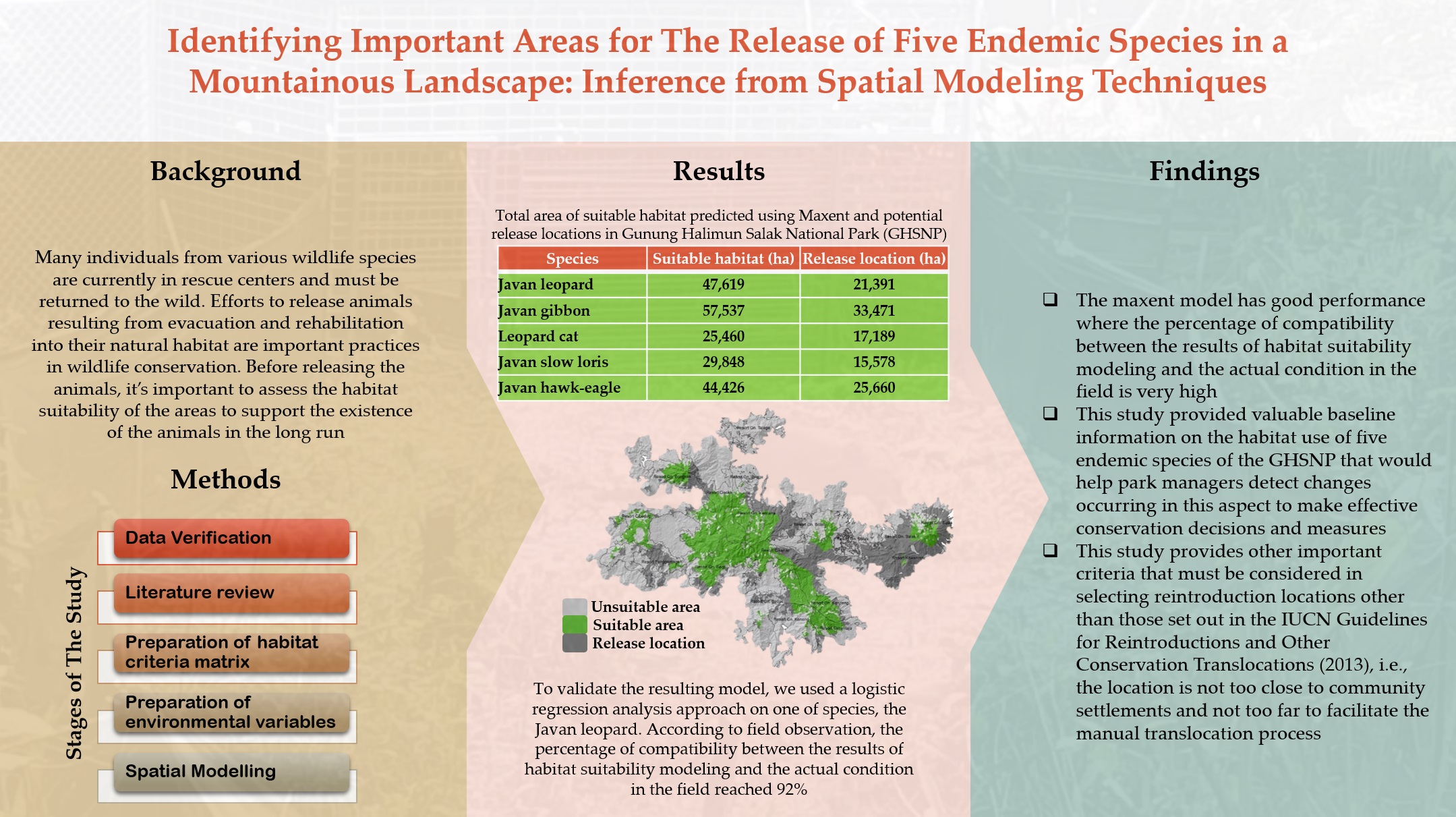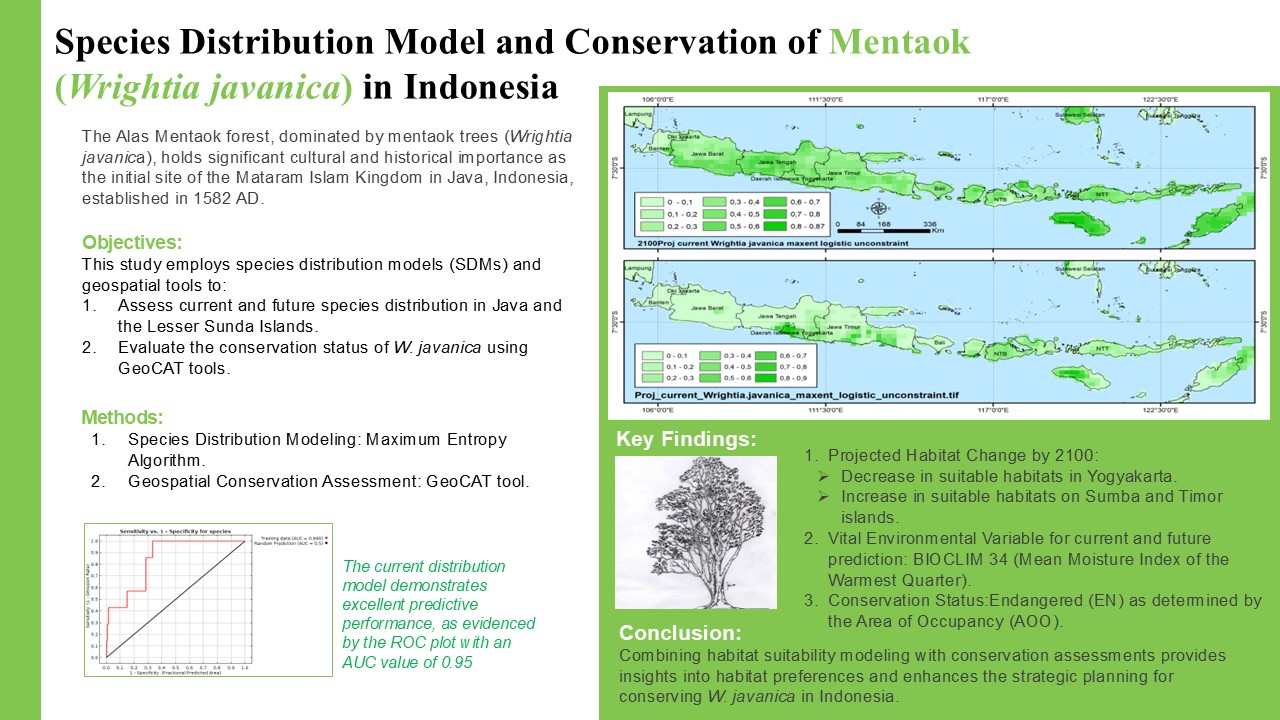Identifying Important Areas for the Release of Five Endemic Species in a Mountainous Landscape: Inference from Spatial Modeling Techniques
Abstract
Efforts to release animals resulting from evacuation and rehabilitation into their natural habitats are important practices in wildlife conservation. Before releasing the animals, it is important to assess the habitat suitability of the areas to support the existence of the animals in the long run. Yet, there is limited study of habitat suitability assessment on national parks as release locations for wild animals. This study aimed to assess the suitable habitat of five charismatic animal species, i.e., Panthera pardus melas, Hylobates moloch, Prinonailurus bengalensis, Nycticebus javanicus, and Nisaetus bartelsi, in Gunung Halimun Salak National Park using Maxent, and to determine potential locations for releasing animal’s species. Models for the P. p. melas show 47,619 ha and 21,391 ha, respectively, suitable as habitat and potential release location, for H. moloch, each is 57,537 ha and 33,471 ha, for P. bengalensis, each is 25,460 ha and 17.189 ha, for N. javanicus, each is 29,848 ha and 15,578 ha, and for N. bartelsi, each is 44,426 ha and 25,660 ha. Our study shows that a suitable habitat can be critical in choosing a wildlife release site. Further consideration of conflict mitigation and practicalities is required to achieve the long-term existence of released species.
References
Ario, A., Kartono, A. P., Prasetyo, L. B., & Supriatna, J. (2018). Post-release adaptation of Javan gibbon (Hylobates moloch) in Mount Malabar Protected Forest, West Java, Indonesia. Biodiversitas Journal of Biological Diversity, 19(4), 1482–1491. https://doi.org/10.13057/biodiv/d190439
Ario, A., Mercusiana, S., Rusiadi, A., Gumilang, R., Wirawan, I. G. G. D. P., & Slamet, T. A. (2022). The Javan leopard Panthera pardus melas (Cuvier, 1809) (Mammalia: Carnivora: Felidae) in West Java, Indonesia: Estimating population density and occupancy. Journal of Threatened Taxa, 14(7), 21331–21346. https://doi.org/10.11609/jot.7483.14.7.21331-21346
Arslan, E. S., & Orucu, O. K. (2020). Maxent modelling of the potential distribution areas of cultural ecosystem services using social media data and GIS. Environment, Development and Sustainability, 23, 2655–2667. https://doi.org/10.1007/s10668-020-00692-3
Bartlet, T. Q., Light, L. E. O, & Brockelman, W. Y. (2016). Long-term home range use in white-handed gibbons (Hylobates lar) in Khao Yai National Park, Thailand. American Journal of Primatology, 78, 192–203. https://doi.org/10.1002/ajp.22492
Cabana, F., Dierenfeld, E., Wirdateti, W., Donati, G., Nekaris, K. A. I. (2017). The seasonal feeding ecology of the Javan slow loris (Nycticebus javanicus). American Journal of Biological Anthropology, 162(4), 768–781. https://doi.org/10.1002/ajpa.23168
Cheyne, S., Gilhooly, L., Hamard, M., Höing, A., Houlihan, P., Kursani, Loken, B., Phillips, A., Rayadin, Y., Capilla, B. R., Rowland, D., Sastramidjaja, W., Spehar, S. T. C., & Zrust, M. (2016). Population mapping of gibbons in Kalimantan, Indonesia: Correlates of gibbon density and vegetation across the species’ range. Endangered Species Research, 30, 133–143. https://doi.org/10.3354/esr00734
Elith, J., Phillips, S. J., Hastie, T., Dudík, M., Chee, Y. E, & Yates, C. J. (2011). A statistical explanation of MaxEnt for ecologists. Diversity and Distribution, 17, 43–57. https://doi.org/10.1111/j.1472-4642.2010.00725.x
Franklin, J. (2009). Mapping species distribution: Spatial inference and prediction. New York: Cambridge University Press.
Fransson, L. (2018). Fine scale habitat and movement patterns of Javan slow loris (Nycticebus javanicus) in Cipaganti, West Java, Indonesia [thesis]. Uppsala University: Committee of Tropical Ecology.
Hamard, M., Cheyne, S. M., & Nijman, V. (2010). Vegetation correlates of gibbon density in the peat-swamp forest of the Sabangau catchment, Central Kalimantan, Indonesia. American Journal of Primatology, 72(7), 607–616. https://doi.org/10.1002/ajp.20815
Hijmans, R. J., Cameron, S. E., Parra, J. L., Jones, P. G., & Jarvis, A. (2005). Very high-resolution interpolated climate surfaces for global land areas. International Journal of Climatology, 25, 1965–1978. https://doi.org/10.1002/joc.1276
Hosmer, D. W., & Lemeshow, S. (2004). Applied logistic regression. John Wiley & Sons.
IUCN Species Survival Commission. (2013). Guidelines for reintroductions and other conservation translocations. Version 1.0. Gland, Switzerland: IUCN Species Survival Commission. Retrieved from https://portals.iucn.org/library/efiles/documents/2013-009.pdf
Jiang, Z., Huete, A. R., Chen, J., Chen, Y., Li, J., Yan, G., & Zhang, X. (2006). Analysis of NDVI and scaled different vegetation index retrievals of vegetation fraction. Remote Sensing of Environment, 101(3), 366–378. https://doi.org/10.1016/j.rse.2006.01.003
Lamichhane, B. R., Lamichhane, S., Regmi, R., Dhungana, M., Thapa, S. K., Prasai, A., Gurung, A., Bhatarai, S., Paudel, R. P., & Subedi, N. (2021). Leopard (Panthera pardus) occupancy in the Chure range of Nepal. Ecology and Evolution, 11(20), 13641–13660. htps://doi.org/10.1002/ece3.8105
Kim, S., Lappan, S., & Choe, J. C. (2011). Diet and ranging behavior of the endangered Javan gibbon (Hylobates moloch) in a submontane tropical rainforest. American Journal of Primatology, 73, 270–280. https://doi.org/10.1002/ajp.20893
McCarthy, J. L., Wibisono, H. T., McCarthy, K. P., Fuller, T. K., & Andayani. (2015). Assessing the distribution and habitat use of four felid species in Bukit Barisan Selatan National Park, Sumatra, Indonesia. Global Ecology and Conservation, 3, 210–221. https://doi.org/10.1016/j.gecco.2014.11.009
[MoF] Ministry of Forestry. (2013). Strategi dan rencana aksi konservasi Owa Jawa (Hylobates moloch) 2013–2022. Jakarta: Ministry of Forestry.
Mardiastuti, A., & Soehartono, T. (2003). Pelaksanaan konvensi CITES di Indonesia. Jakarta: Japan International Cooperation Agency (JICA).
Nekaris, K. A. I. (2014). Extreme primates: Ecology and evolution of Asian lorises. Evolutionary Anthropology: Issues, News, and Reviews, 23(5), 177–187. https://doi.org/10.1002/evan.21425
Nekaris, K. A. I., Poindexter, S., Reinhardt, K. D., Sigaud, M., Cabana, F., Wirdateti, W., & Nijman, V. (2017). Coexistence between Javan slow lorises (Nycticebus javanicus) and humans in a dynamic agroforestry landscape in West Java, Indonesia. International Journal of Primatology, 38, 303–320. https://doi.org/10.1007/s10764-017-9960-2
Nijman, V., Smith, J. H., Foreman, G., Campera, M., Feddema, K., & Nekaris, K. A. I. (2021). Monitoring the trade of legally protected wildlife on facebook and instagram illustrated by the advertising and sale of apes in Indonesia. Diversity, 13(6), 236. https://doi.org/10.3390/d13060236
Nijman, V., Morcatty, T. Q., Feddema, K., Campera, M., & Nekaris, K. A. I. (2022). Disentangling the legal and illegal wildlife trade–insights from Indonesian wildlife market surveys. Animals, 12(5), 628. https://doi.org/10.3390/ani12050628
Othman, Y. A., Ayasrah, B., & Al-Kofahi, S. (2023). Habitat selection to reintroduce Iris bismarckiana in semi-arid environments. Diversity, 15(9), 957. https://doi.org/10.3390/d15090957
Parikesit, P., Okubo, S., Husodo, T., Takeuchi, K., & Muhamad, D. (2012). Biodiversity issues in Indonesia with special reference to biodiversity in human-dominated landscapes. In S. Nakano, T. Yahara, & T. Nakashizuka (Eds.), The biodiversity observation network in the Asia-Pasific region: Toward further of monitoring (pp. 93–110). Springer.
Phillips, S. J., Anderson, R. P., & Schapire, R. E. (2006). Maximum entropy modeling of species geographic distributions. Ecological Modelling, 190, 231–259. https://doi.org/10.1016/j.ecolmodel.2005.03.026
Phillips, S. J., & Dudik, M. (2008). Modeling of species distributions with Maxent: New extensions and a comprehensive evaluation. Ecography, 31, 161–175. https://doi.org/10.1111/j.0906-7590.2008.5203.x
Phillips, S. J., Dudik, M., & Elith, J. (2009). Sample selection bias and presence-only distribution models: Implications for background and pseudo-absence data. Ecological Applications, 19(1), 181–197. https://doi.org/10.1890/07-2153.1
Pliosungnoen M, Gale G, Savini T. 2010. Density and microhabitat use of bengal slow loris in Primary Forest and Non-Native Plantation Forest. American Journal of Primatology 72: 1108-17. https://doi.org/10.1002/ajp.20875.
Rahman, D. A. (2020). Ecological niche and potential distribution of the endangered Bos javanicus in south-western Java, Indonesia. Therya, 11, 57–68. https://doi.org/10.12933/therya-20-840
Rahman, D. A., Condro, A. A., & Giri, M. S. (2022). Model distribusi spesies: Maximum entropy. Bogor: IPB University Press.
Rahman, D. A., Condro, A. A., Rianti, P., Masy’ud, B., Aulagnier, S., & Semiadi, G. (2020). Geographical analysis of the Javan deer distribution in Indonesia and priorities for landscape conservation. Journal for Nature Conservation, 54, 125795. https://doi.org/10.1016/j.jnc.2020.125795
Rahman, D. A., Gonzalez, G., Haryono, M., Muhtarom, A., Firdaus, A. Y., & Aulagnier, S. (2017). Factors affecting seasonal habitat use and predicted range of two tropical deer in Indonesian rainforest. Acta Oecologica, 82, 41–51. https://doi.org/10.1016/j.actao.2017.05.008
Rahman, D. A., Rianti, P., Muhiban, M., Muhtarom, A., Rahmat, U. M., Santosa, Y., Aulagnier, S. (2018). Density and spatial partitioning of endangered sympatric Javan leopard (Felidae) and dhole (Canidae) in a tropical forest landscape. Folia Zoologica, 67, 207–219. https://doi.org/10.25225/fozo.v67.i3-4.a8.2018
Rahman, D. A., Rinaldi, D., Kuswanda, W., Siregar, R., Noorchasanatun, F., Hakim, F., Arief, H., & Putro, H. R. (2019). Determining the landscape priority and their threats for the Critically Endangered Pongo tapanuliensis population in Indonesia. Biodiversitas, 20, 3584–3592. https://doi.org/10.1305/biodiv/d201217
Sari, D. F., Budiadi, & Imron, M. A. (2020). The utilization of trees by endangered primate species Javan slow loris (Nycticebus javanicus) in shade-grown coffee agroforestry of Central Java. IOP Conference Series: Earth and Environmental Science, 449(1), 012044. https://doi.org/10.1088/1755-1315/449/1/012044
Slater, H., & Mixhael, E. (2012). Predicting the current and future potential distributions of lymphatic filariasis in Africa using maximum entropy ecological niche modelling. PLoS ONE, 7(2), e32202. https://doi.org/10.1371/journal.pone.0032202
Sodik, M., Pudyatmoko, S., Semedi, P., & Imron, M. A. (2019). Resource selection by Javan slow loris Nycticebus javanicus E. Geoffroy, 1812 (Mammalia: Primates: Lorisidae) in a lowland fragmented forest in Central Java, Indonesia. Journal of Threatened Taxa, 11, (6), 13667–13679. https://doi.org/10.11609/jott.4781.11.6.13667-13679
Sodik, M., Pudyatmoko, S., Semedi, P., Tafrichan, M., & Imron, M. A. (2020). Better providers of habitat for Javan slow loris (Nycticebus javanicus E. Geoffroy 1812): A species distribution modeling approach in Central Java, Indonesia. Biodiversitas Journal of Biological Diversity, 21(5), 1890–1900. https://doi.org/10.13057/biodiv/d210515
Supriatna, J. (2006). Conservation programs for the endangered Javan gibbon (Hylobates moloch). Primate Conservation, 21, 155–162. https://doi.org/10.1896/0898-6207.21.1.155
Wibisono, H. T., Wahyudi, H. A., Wilianto, E., Pinondang, I. M. R., Primajati, M., & Liswanto, D. (2018). Identifying priority conservation landscapes and actions for the Critically Endangered Javan leopard in Indonesia: Conserving the last large carnivore in Java Island. PLoS ONE, 13(6), e0198369. https://doi.org/10.1371/journal.pone.0198369
Wibisono, H., Wilianto, E., Pinondang, I., Rahman, D. A., & Chandradewi, D. (2021). Panthera pardus ssp. melas. The IUCN Red List of Threatened Species 2021: e.T15962A50660931. Retrieved from https://doi.org/10.2305/IUCN.UK.2021-2.RLTS.T15962A50660931.en
Voskamp, A., Rode-Margono, J., Coudrat, C., Wirdateti, Abinawanto, A., Wilson, R., & Nekaris, K. A. I. (2014). Modelling the habitat use and distribution of the threatened Javan slow loris Nycticebus Javanicus. Endangered Species Research, 23, 277–286. https://doi.org/10.3354/esr00574
Yang, X., Kushwaha, S. P. S., Saran, S., Xu, J., & Roy, P. S. (2013). Maxent modeling for predicting the justicia potential distribution of medicinal plant, adhatoda L. in Lesser Himalayan foothills. Ecological Engineering, 51, 83–87. https://doi.org/10.1016/j.ecoleng.2012.12.004
Young, N., Carter, L., & Evangelista, P. (2011). A Maxent model v3.3.3e tutorial (ArcGIS v10). Colorado State University.
Zhang, J., Jiang, F., Li, G., Qin, W., Li, S., Gao, H., Cai, Z., Lin, G., & Zhang, T. (2019). Maxent modeling for predicting the spatial distribution of three raptors in the Sanjiangyuan National Park, China. Ecology and Evolution, 9, 6643–6654. https://doi.org/10.1002/ece3.5243
Authors

This work is licensed under a Creative Commons Attribution 4.0 International License.
Jurnal Manajemen Hutan Tropika is an open access journal which means that all contents is freely available without charge to the user or his/her institution. Users are allowed to read, download, copy, distribute, print, search, or link to the full texts of the articles in this journal without asking prior permission from the publisher or the author. This is in accordance with the Budapest Open Access Initiative (BOAI) definition of open access.





